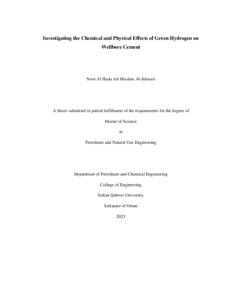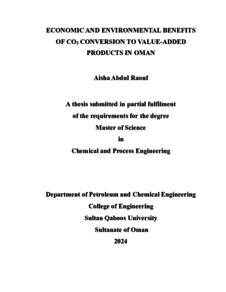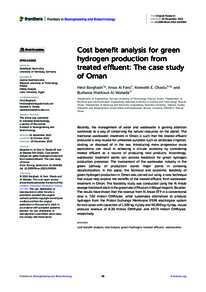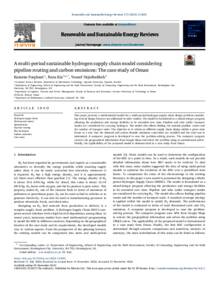وثيقة
Investigating the chemical and physical effects of green hydrogen on wellbore cement.
عناوين أخرى
دراسة التأثيرات الكيميائية والفيزيائية للهيدروجين الأخضر على أسمنت الآبار
الناشر
Sultan Qaboos University.
ميلادي
2023
اللغة
الأنجليزية
الملخص الإنجليزي
Green hydrogen is rapidly emerging as a sustainable energy source of global
significance. The utilization of water electrolysis for hydrogen production offers
environmental advantages and enhances energy security in various sectors, including
transportation. However, the substantial challenge lies in effectively storing the hydrogen
being produced. To address this, repurposing abandoned gas and oil reservoirs presents a
convenient option for establishing underground hydrogen storage (UHS) facilities,
capitalizing on the existing infrastructure. These reservoirs possess favorable geological
characteristics, stable caprock, and readily available surface and subsurface equipment,
making them suitable for UHS operations. The success of UHS is highly dependent on the
integrity of injection, production, and blocked wells. Inadequate integrity can result in
environmental hazards and inefficient storage practices. The cement sheath encasing the
wellbore plays a critical role in preserving well integrity by preventing hydrogen from
escaping through cracks, weak areas, or other openings that could lead to uncontrolled
emissions or contamination of surrounding formations. Furthermore, stored hydrogen can
influence the stability and rheological properties of the cement, adversely impacting the
storage process. Consequently, this research involves the experimental exposure of wet
cement to hydrogen exposure for varying durations to evaluate the effects on the
rheological, mechanical, and chemical properties of the cement. The findings indicate that
exposure to hydrogen weakens the cement's compressive strength and density, while
simultaneously increasing the viscosity of the cement slurry. XRF analysis reveals the
presence of significant amounts of Calcite and Portlandite in each sample, both before and
after exposure to hydrogen. XRD results indicate a decrease in the intensity and full width
at half-maximum (FWHM) of the calcite peak after exposure to hydrogen. On the
contrary, the FWHM and peak intensity of the portlandite phase increased following the
exposure process. The FT-IR spectra demonstrate that longer hydrogen exposure times
lead to increased water adsorption in the samples. Furthermore, there is a decreasing trend
in the peak intensity of the carbonate group with prolonged hydrogen exposure. The XPS
study reveals that longer exposure to hydrogen resulted in the formation of more calcium
hydroxide phases and the emergence of new carbon-oxygen linkages in the treated
samples. These findings suggest that hydrogen and cement undergo chemical reactions.
المجموعة
URL المصدر
الملخص العربي
يبرز الهيدروجين الاخضر بسرعة كمصدر للطاقة المستدامة ذات الاهمية العالمية . يوفر تحليل المياه كهربائيا لانتاج الهيدروجين مزايا بيئية ويعزز أمن الطاقة في مختلف القطاعات ، بما في ذلك الصناعات والنقل وغير ذلك . ومع ذلك ، يكمن التحدي الكبير في التخزين الفعال للهيدروجين الوفير الذي يُنتَج. ولمعالجة هذا الامر، تعد إعادة استخدام خزانات الغاز والنفط المهجورة خيارا مناسبا لإنشاء مرافق تخزين وإدارة وتشغيل الهيدروجين تحت الارض والاستفادة من البنية التحتية الحالية . تمتلك هذه الخزانات خصائص جيولوجية مواتية ، وصخور غطاء مستقرة ، ومعدات سطحية وتحت سطحية متاحة بسهولة ، مما يجعلها مناسبة تماما لعمليات تخزين الهيدروجين تحت الارض. يعتمد نجاح تخزين الهيدروجين تحت الارض بشكل كبير على سالمة الحقن والانتاج والابار المسدودة . يمكن أن تؤدي السالمة غير الكافية إلى مخاطر بيئية وتخزين غير فعال . يلعب الغالف الاسمنتي الذي يغلف حفرة البئر دورا مهما في الحفاظ على سالمة البئر عن طريق منع الهيدروجين من الهروب من خالل الشقوق أو المناطق الضعيفة أو الفتحات الاخرى التي قد تؤدي إلى انبعاثات غير خاضعة للرقابة أو تلوث محيط المنطقة . عالوة على ذلك ، يمكن أن يؤثر الهيدروجين المخزن على الاستقرار والخصائص الريولوجية لألسمنت ، مما يؤثر سلبا على عملية التخزين . وبالتالي ، فإن هذا البحث ينطوي على تعريض الاسمنت الرطب للهيدروجين تجريبيا لفترات متفاوتة لتقييم التأثيرات على الخواص الدائرية والميكانيكية والكيميائية للأسمنت. تشير النتائج إلى أن التعرض للهيدروجين يضعف كثافة الاسمنت ومقاومته لالنضغاط ، بينما يزيد في نفس الوقت من لزوجة الاسمنت الرطب يكشف تحليل فلورية الاشعة السينية عن وجود كميات كبيرة من الكالسيت والبورتلانديت في كل عينة ، قبل وبعد التعرض للهيدروجين. تشير نتائج حيود الاشعة السينية إلى انخفاض في الكثافة والعرض الكامل عند نصف الحد الاقصى لقمة ا لكالسيت بعد التعرض للهيدروجين. على العكس من ذلك ، زاد العرض الكامل عند نصف الحد الاقصى كما زادت شدة الذروة لمرحلة البورتالنديت بعد عملية التعرض للهيدروجين. توضح نتائج مطيافية الاشعة تحت الحمراء باستخدام تحويل فورييه أن أوقات التعرض الطويلة للهيدروجين تؤدي إلى زيادة امتصاص الماء على العينات. بالاضافة إلى ذلك ، هناك اتجاه تنازلي في شدة ذروة مجموعة الكربونات مع التعرض الطويل للهيدروجين. تكشف دراسة مطيافية الاشعة السينية بالالكترون الضوئي أن التعرض الطويل للهيدروجين أدى إلى تكوين المزيد من مراحل هيدروكسيد الكالسيوم وظهور روابط جديدة بين الكربون والاكسجين في العينات المعالجة.
قالب العنصر
الرسائل والأطروحات الجامعية





